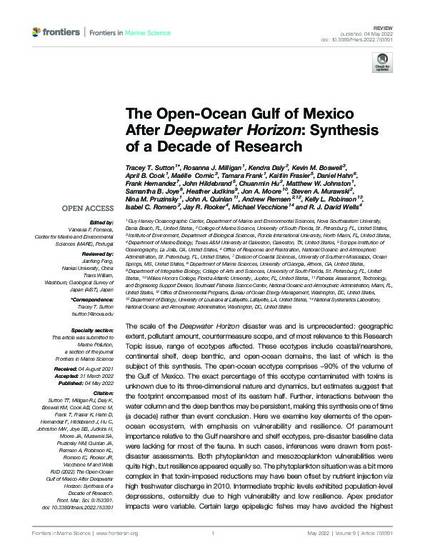
- Epipelagic,
- mesopelagc,
- bathypelagic,
- Oil spill accident,
- pollution,
- deep sea
The scale of the Deepwater Horizon disaster was and is unprecedented: geographic extent, pollutant amount, countermeasure scope, and of most relevance to this Research Topic issue, range of ecotypes affected. These ecotypes include coastal/nearshore, continental shelf, deep benthic, and open-ocean domains, the last of which is the subject of this synthesis. The open-ocean ecotype comprises ~90% of the volume of the Gulf of Mexico. The exact percentage of this ecotype contaminated with toxins is unknown due to its three-dimensional nature and dynamics, but estimates suggest that the footprint encompassed most of its eastern half. Further, interactions between the water column and the deep benthos may be persistent, making this synthesis one of time (a decade) rather than event conclusion. Here we examine key elements of the open-ocean ecosystem, with emphasis on vulnerability and resilience. Of paramount importance relative to the Gulf nearshore and shelf ecotypes, pre-disaster baseline data were lacking for most of the fauna. In such cases, inferences were drawn from post-disaster assessments. Both phytoplankton and mesozooplankton vulnerabilities were quite high, but resilience appeared equally so. The phytoplankton situation was a bit more complex in that toxin-imposed reductions may have been offset by nutrient injection via high freshwater discharge in 2010. Intermediate trophic levels exhibited population-level depressions, ostensibly due to high vulnerability and low resilience. Apex predator impacts were variable. Certain large epipelagic fishes may have avoided the highest concentrations of hydrocarbons/dispersant, and thus larval abundances returned to pre-disaster levels of variability and abundance within a few years after a steep initial decline. Oceanic cetaceans, particularly shallow-diving stenellid dolphins, did not appear to avoid oiled waters and exhibited strong declines in the northern Gulf. Given that population declines of many open-ocean taxa appear to be ongoing a decade later, we conclude that this largest of Gulf ecosystem components, like its deep-benthic counterpart, is as fragile as it is voluminous. This is particularly concerning given the rapid, and likely irreversible, shift to deeper waters by the US and Mexican oil industries in concert with the higher likelihood of accidents with increasing platform depth.
Frontiers in Marine Science, v. 9, art. 753391
Available at: http://works.bepress.com/kendra_daly/106/
